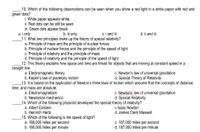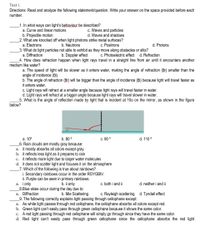
Directions: Read and analyze the following statement/question. Write your answer on the space provided before each number.
_____1. In what ways can light’s behaviour be described?
a. Curve and linear motions
c. Waves and particles
b. Projectile motion
d. Waves and shadows
_____2. What are knocked off when light photons strike metal surfaces?
a. Electrons
b. Neutrons
c. Positrons
d. Protons
_____3. What do light particles not able to exhibit as they move along obstacles or slits?
a. Diffraction
b. Doppler effect
c.
d. Refraction
_____4. How does refraction happen when light rays travel in a straight line from air until it encounters another medium like water?
a. The
b. The angle of refraction (θr) will be bigger than the angle of incidence (θi) because light will travel faster as it enters water.
c. Light rays will refract at a smaller angle because light rays will travel faster in water.
d. Light rays will refract at a bigger angle because light rays will travel slower in water.
_____5. What is the angle of reflection made by light that is incident at 10o on the mirror, as shown in the figure below?
a. 10º b. 80 º c. 90 º d. 110 º
_____6. Rain clouds are mostly gray because:
a. it mostly absorbs all colors except gray
b. it reflects less light as it prepares to rain
c. it reflects more light due to larger water molecules
d. it does not scatter light and focuses it on the atmosphere
_____7. Which of the following is true about rainbows?
i. Secondary rainbows occur in the order ROYGBIV.
ii. Purple can be seen in primary rainbows.
a. i only
b. ii only
c. both i and ii
d. neither i and ii
_____8.Blue skies occur during the day due to:
a. Diffraction
b. Mie Scattering
c. Rayleigh scattering
d. Tyndall effect
_____9. The following correctly explains light passing through cellophane except:
a. As white light passes through red cellophane, the cellophane absorbs all colors except red.
b. Green light can’t easily pass through green cellophane because it shows the same color.
c. A red light passing through red cellophane will simply go through since they have the same color.
d. Red light can’t easily pass through green cellophane since the cellophane absorbs the red light
_____10. Which of the following observations can be seen when you shine a red light in a white paper with red and green dots?
i. White paper appears white.
ii. Red dots can be still be seen.
iii. Green dots appear black.
a. i only b. iii only c. i and iii d. ii and iii
_____11. What two principles make up the theory of special relativity?
a. Principle of mass and the principle of nuclear forces
b. Principle of nuclear forces and the principle of the speed of light
c. Principle of relativity and the principle of mass
d. Principle of relativity and the principle of the speed of light
_____12. This theory explains how space and time are linked for objects that are moving at constant speed in a straight line.
a. Electromagnetic theory
c. Newton’s law of universal gravitation
b. Kepler’s law of planetary motion
d.
_____13. It is based on the application of Newton’s three laws of motion which assume that the concepts of distance, time, and mass are absolute.
a.
c. Newtons’ law of universal gravitation
b. Newtonian mechanicsd
d Special Relativity
_____14. Which of the following physicist developed the special theory of relativity?
a. Albert Einstein
c. Isaac Newton
b. Heinrich Hertz
d. James Clerk Maxwell
_____15. Which of the following is the speed of light?
a. 186,000 miles per second
c. 187,000 miles per second
b. 186,000 miles per minute
d. 187,000 miles per minute


Trending nowThis is a popular solution!
Step by stepSolved in 2 steps

 Applications and Investigations in Earth Science ...Earth ScienceISBN:9780134746241Author:Edward J. Tarbuck, Frederick K. Lutgens, Dennis G. TasaPublisher:PEARSON
Applications and Investigations in Earth Science ...Earth ScienceISBN:9780134746241Author:Edward J. Tarbuck, Frederick K. Lutgens, Dennis G. TasaPublisher:PEARSON Exercises for Weather & Climate (9th Edition)Earth ScienceISBN:9780134041360Author:Greg CarbonePublisher:PEARSON
Exercises for Weather & Climate (9th Edition)Earth ScienceISBN:9780134041360Author:Greg CarbonePublisher:PEARSON Environmental ScienceEarth ScienceISBN:9781260153125Author:William P Cunningham Prof., Mary Ann Cunningham ProfessorPublisher:McGraw-Hill Education
Environmental ScienceEarth ScienceISBN:9781260153125Author:William P Cunningham Prof., Mary Ann Cunningham ProfessorPublisher:McGraw-Hill Education Earth Science (15th Edition)Earth ScienceISBN:9780134543536Author:Edward J. Tarbuck, Frederick K. Lutgens, Dennis G. TasaPublisher:PEARSON
Earth Science (15th Edition)Earth ScienceISBN:9780134543536Author:Edward J. Tarbuck, Frederick K. Lutgens, Dennis G. TasaPublisher:PEARSON Environmental Science (MindTap Course List)Earth ScienceISBN:9781337569613Author:G. Tyler Miller, Scott SpoolmanPublisher:Cengage Learning
Environmental Science (MindTap Course List)Earth ScienceISBN:9781337569613Author:G. Tyler Miller, Scott SpoolmanPublisher:Cengage Learning Physical GeologyEarth ScienceISBN:9781259916823Author:Plummer, Charles C., CARLSON, Diane H., Hammersley, LisaPublisher:Mcgraw-hill Education,
Physical GeologyEarth ScienceISBN:9781259916823Author:Plummer, Charles C., CARLSON, Diane H., Hammersley, LisaPublisher:Mcgraw-hill Education,





